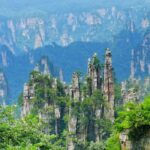
“After visiting the five great mountains, you won’t look at other mountains; after visiting Huangshan, you won’t even look at the five great mountains.” This saying firmly establishes Huangshan’s position among the mountains of China. It is well-known that Huangshan boasts “four wonders”: peculiar pines, oddly-shaped rocks, sea of clouds, and hot springs. If you’re lucky, you can even witness the breathtaking beauty of sunrise and sunset.

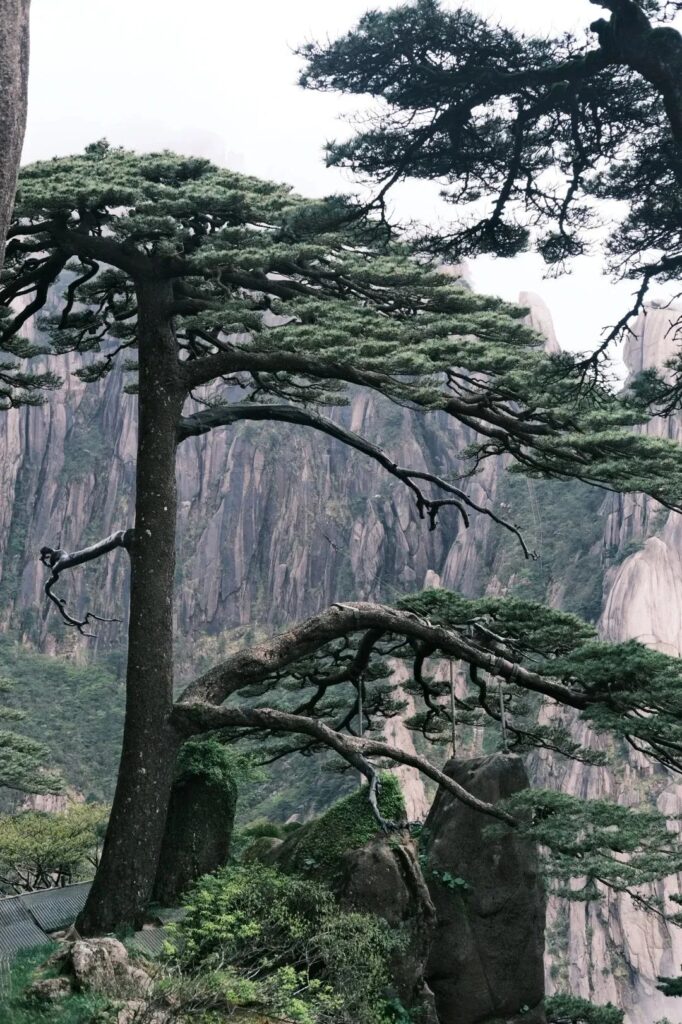

Huangshan is suitable for visiting all year round, offering the elegance of southern China and the snowy landscapes of the north during winter. Only after visiting Huangshan will you realize that even the most exquisite Chinese ink paintings are too conservative to capture its true beauty!

Xiandu Peak, the most precipitous of the three main peaks in Huangshan, is renowned as the “gathering place of immortals.” A local saying goes, “If you don’t reach Xiandu Peak, your trip is in vain.”

However, before embarking on your journey, it’s crucial to understand that Huangshan is unlike other mountains. There is no absolute summit, but rather several peaks, three cable cars, and multiple scenic areas.
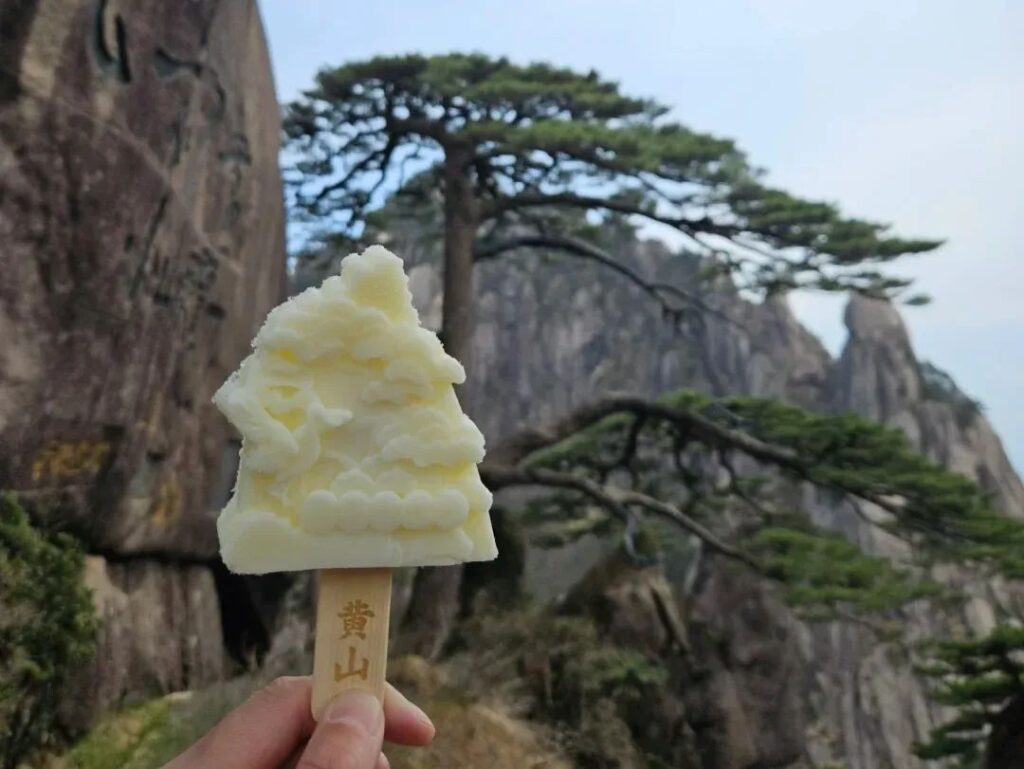
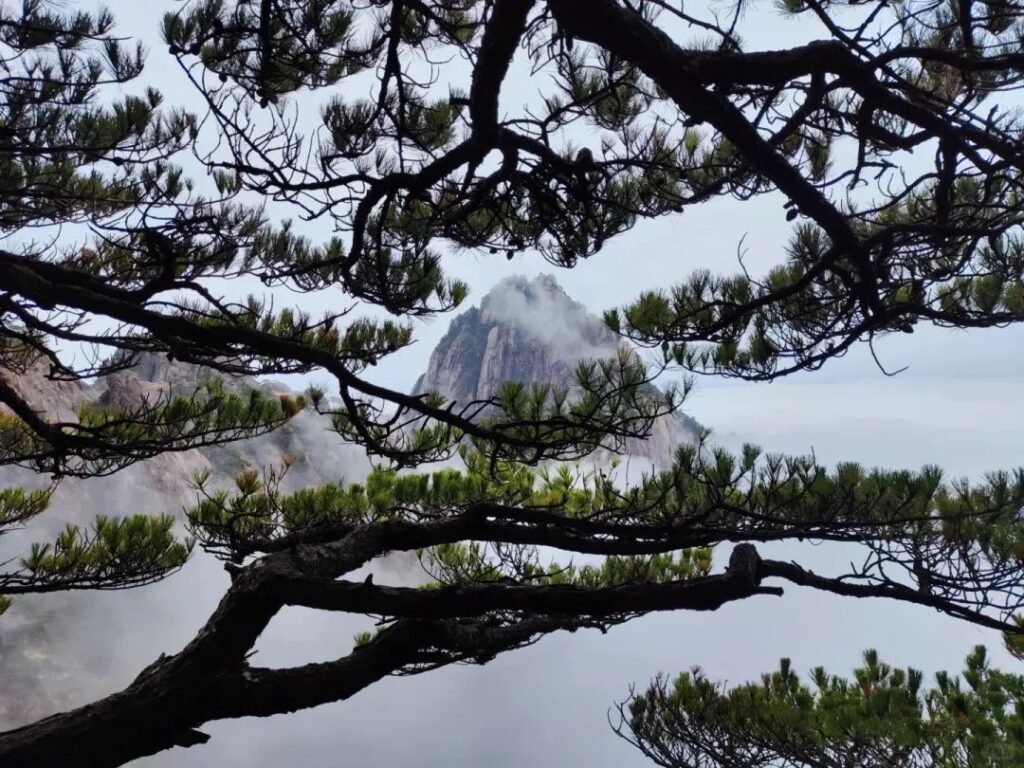
Therefore, to fully enjoy your Huangshan experience, it is essential to study the map and plan your route in advance. This way, you can hike with ease and make the most of your trip!
To help you out, we have compiled a list of common routes and travel tips for Huangshan, including attractions, routes, tickets, transportation, food, and accommodation. Even if you’re a first-time visitor to Huangshan, this guide will help you navigate the mountain with confidence.
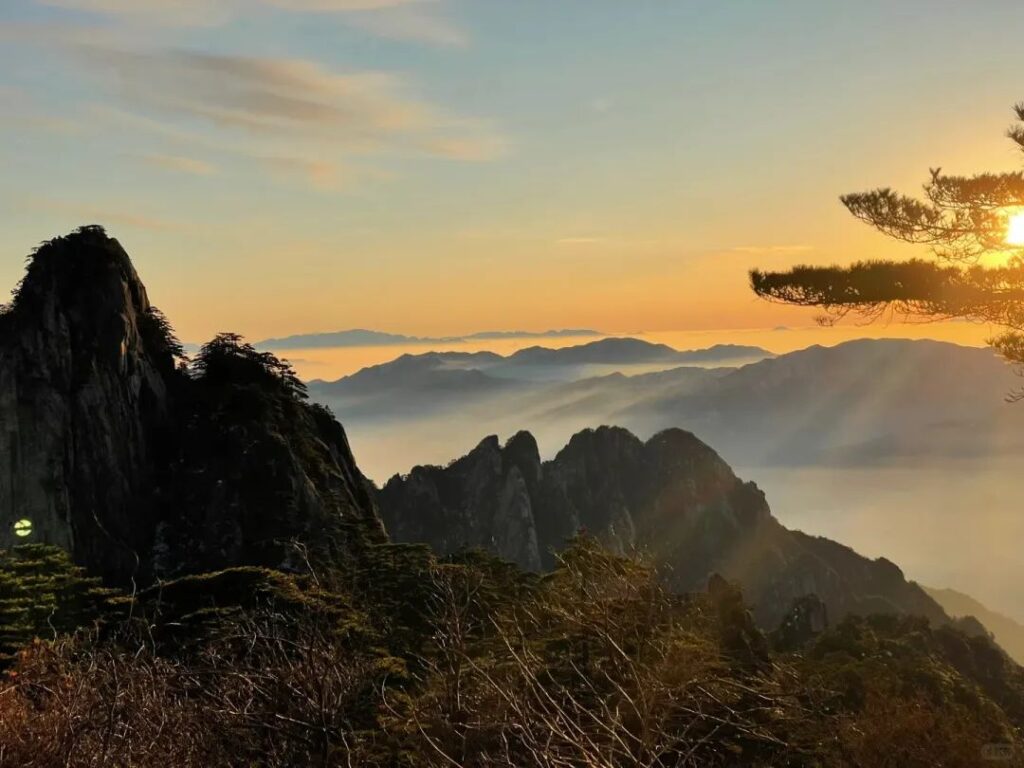
Located in Huangshan City, Anhui Province, China, Huangshan, formerly known as Mount Yi, was renamed during the Tang Dynasty after the legendary resting place of the Yellow Emperor.
Huangshan is a renowned tourist destination, hailed as “the most beautiful mountain under heaven.” It is world-famous for its peculiar pines, oddly-shaped rocks, sea of clouds, hot springs, and winter snow, attracting countless visitors to admire its beauty.
Huangshan’s “Four Wonders”
Shixin Peak
Shixin Peak is home to many famous peculiar pines, such as the Guest-Greeting Pine and the Guest-Sending Pine, which are representative of Huangshan’s unique pine trees.
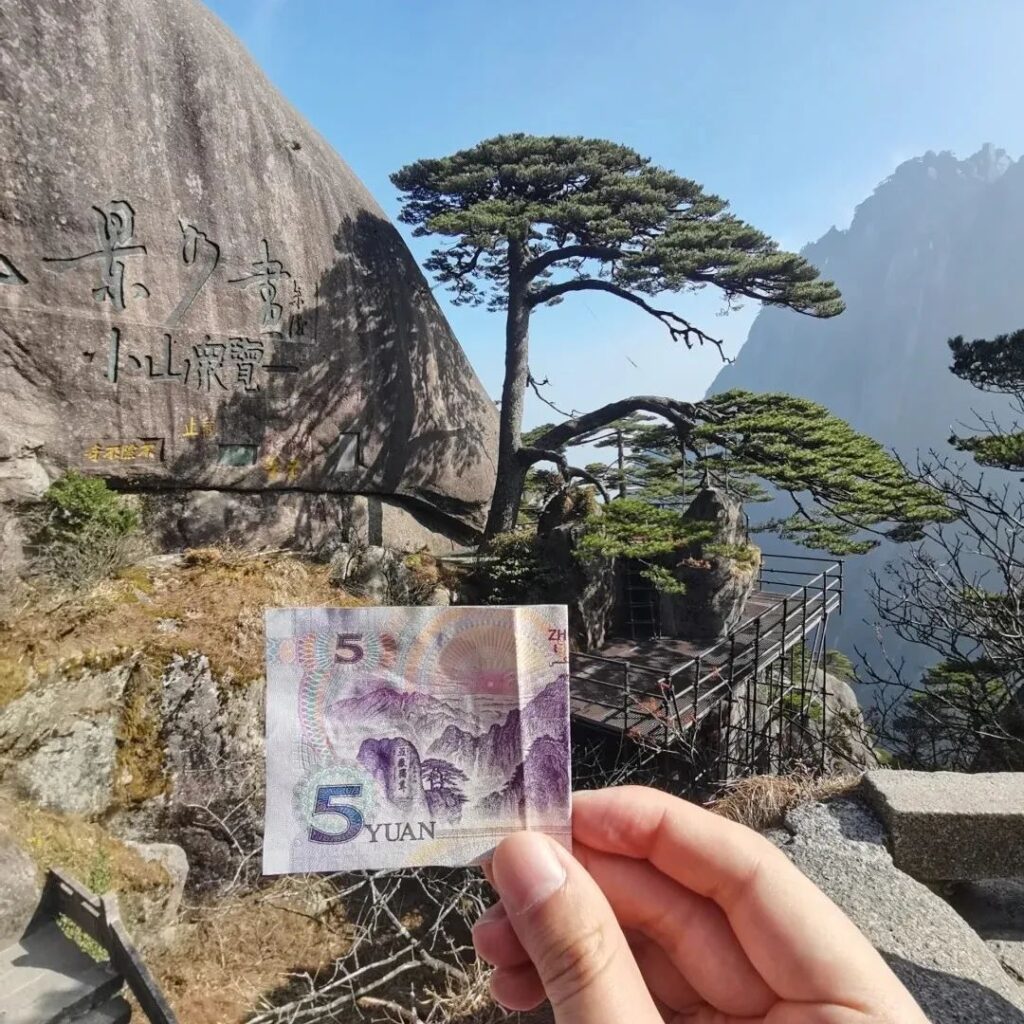
Bright Summit
As the second-highest peak in Huangshan, Bright Summit stands at an altitude of 1,860 meters. From here, visitors can enjoy a panoramic view of Huangshan’s stunning scenery, making it a popular spot for photography enthusiasts.
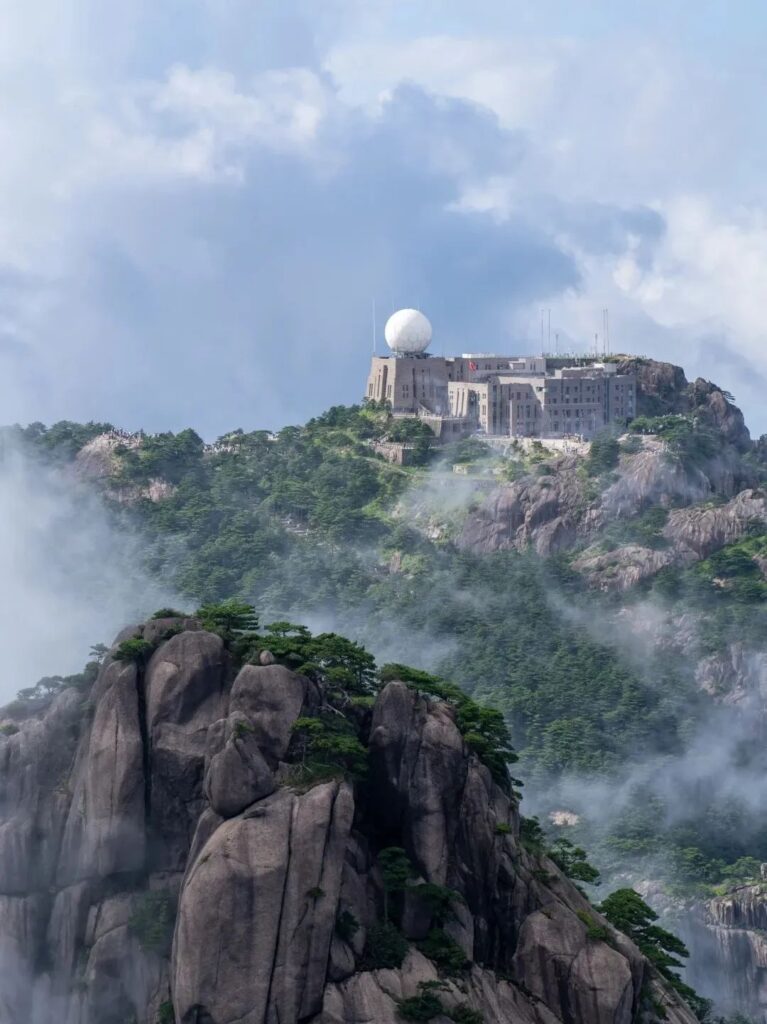
Lotus Peak
Lotus Peak is the highest peak in Huangshan, reaching an altitude of 1,864 meters. The summit features a platform shaped like a lotus flower, hence its name.
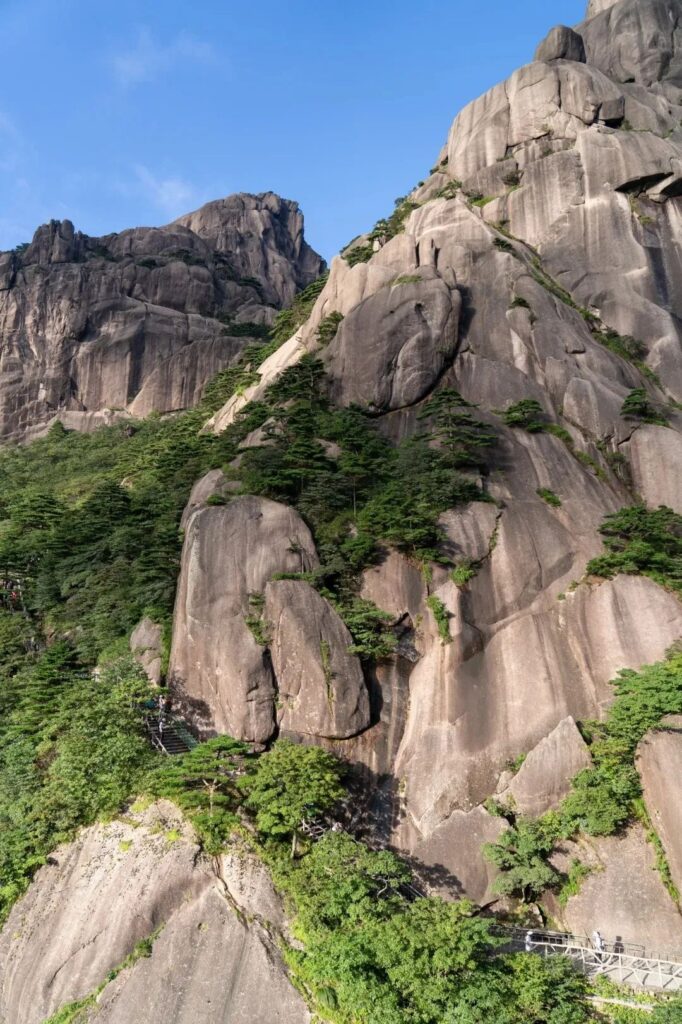
Sea of Clouds
Huangshan’s sea of clouds is truly magnificent, especially during sunrise when the clouds and the rosy glow of dawn create a breathtaking view that is simply unforgettable.
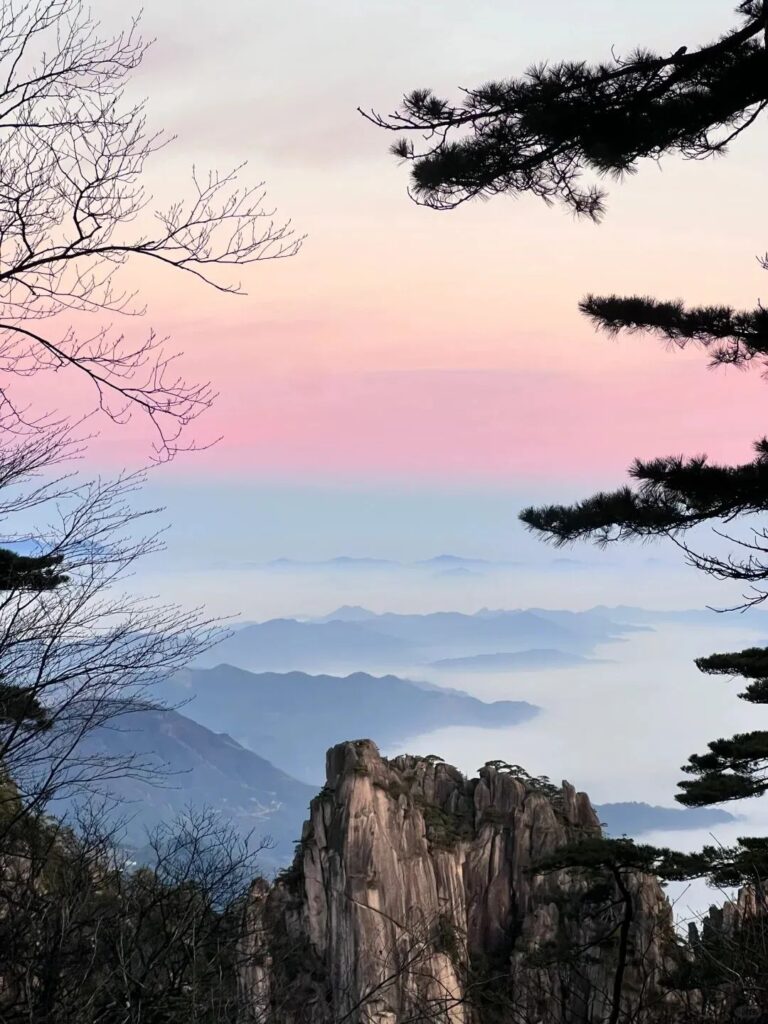
Monkey Watching the Sea
“On a steep mountain peak, there sits a monkey. It hugs its legs with both arms and remains motionless, perched on the mountaintop, gazing at the rolling sea of clouds.”
This description of the Monkey Watching the Sea, found in Chinese elementary school textbooks, portrays one of the amazing sights in Huangshan.

Hot Springs
Huangshan’s hot springs have been famous since ancient times, known for their clear water quality. There are numerous hot spring hotels and pools in the area for visitors to experience, catering to various preferences and needs.
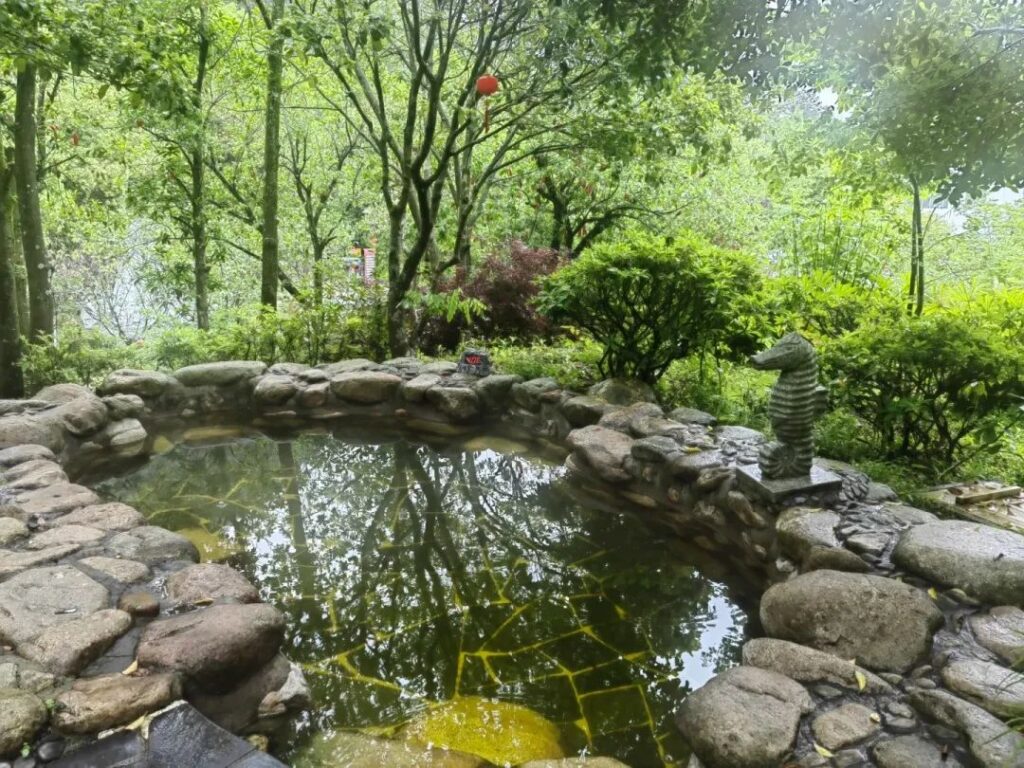
Huangshan Hiking Routes
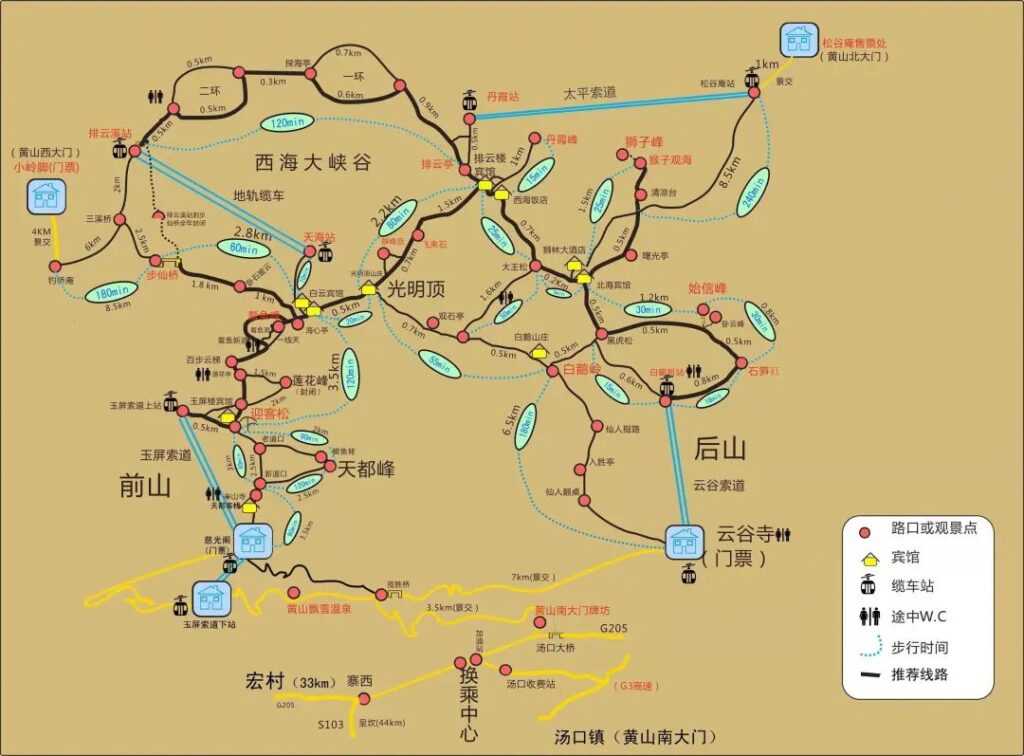
Easy Route (4 hours or more)
Skipping West Sea Grand Canyon and Tiandu Peak
This route is the most relaxed, utilizing cable cars for ascent and descent, making it the top choice for those with limited physical fitness. It is recommended to ascend from the back mountain, as the descent is gentler and more leisurely. Alternatively, you can ascend from the front mountain by reversing the route.
Route: Yungu Cable Car – Shixin Peak – Monkey Watching the Sea – Paiyun Pavilion (return) – Flying Stone – Bright Summit – Aoyu Peak – One Line Sky – Hundred Steps Ladder – Guest-Greeting Pine – Yuping Cable Car
Moderate Route (5 hours or more)
Skipping Flying Stone and Tiandu Peak
This route is exclusive to ascending from the back mountain and offers a glimpse of the stunning West Sea Grand Canyon, but you will have to skip the Flying Stone.
Route: Yungu Cable Car – Shixin Peak – Monkey Watching the Sea – West Sea Grand Canyon – Mini Train uphill – Bright Summit (return) – Aoyu Peak – One Line Sky – Hundred Steps Ladder – Guest-Greeting Pine – Yuping Cable Car
Classic Route (6 hours or more)
Skipping Tiandu Peak
This route covers most of Huangshan’s attractions and is the most classic one-day tour. There are two versions: ascending from the front mountain or the back mountain.
Route (ascending from the back mountain): Yungu Cable Car – Shixin Peak – Monkey Watching the Sea – Grand King Pine – Bright Summit – Flying Stone – West Sea Grand Canyon – Mini Train uphill – Aoyu Peak – One Line Sky – Hundred Steps Ladder – Guest-Greeting Pine – Yuping Cable Car
Recommended Route (9 hours or more)
Skipping Buxian Bridge
This route covers the most attractions and does not use the cable car when ascending from the front mountain. Except for the Buxian Bridge area, all other attractions can be reached. A one-day trip requires an early start, while a two-day tour is more reasonable.
Route (ascending from the back mountain): Yungu Cable Car – Shixin Peak – Monkey Watching the Sea – Grand King Pine – Bright Summit – Flying Stone – West Sea Grand Canyon – Mini Train uphill – Aoyu Peak – One Line Sky – Hundred Steps Ladder – Guest-Greeting Pine – Tiandu Peak – Banshan Temple, walk to Ciguang Pavilion
Route (ascending from the front mountain): Ciguang Pavilion (walking) – Banshan Temple – Tiandu Peak – Guest-Greeting Pine – Hundred Steps Ladder – One Line Sky – Aoyu Peak – Bright Summit – Flying Stone – West Sea Grand Canyon – Mini Train uphill – Bright Summit – Grand King Pine – Monkey Watching the Sea – Shixin Peak – Yungu Cable Car
“Special Forces” Route (12 hours or more)
This route is similar to the recommended route, with the main difference being that instead of taking the mini train, you will hike up and down the West Sea Grand Canyon. Along the way, you will pass through the rarely visited Sanxikou and Buxian Bridge areas. This is the most exhausting route but also the most complete in terms of attractions. A two-day tour is highly recommended.
Important Advice for Your Huangshan Trip
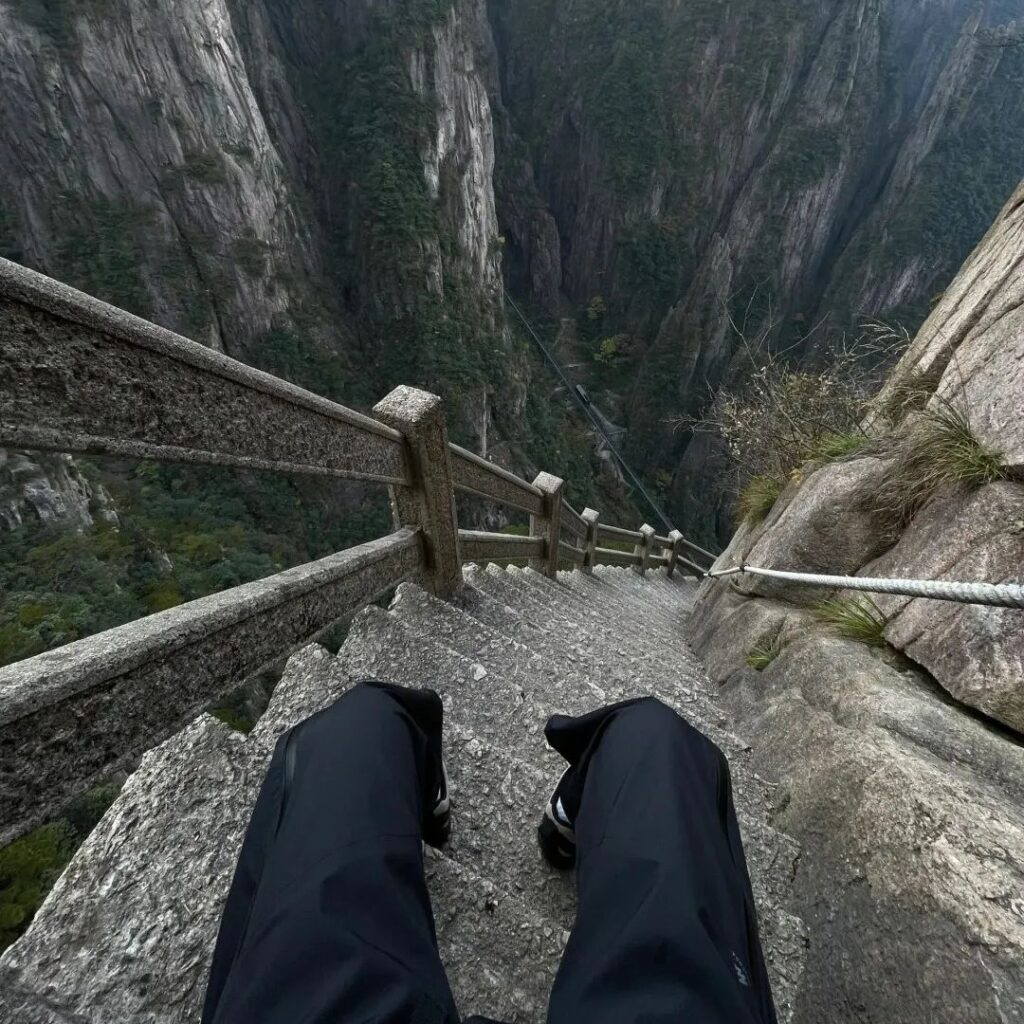
Tips for Ascending the Mountain
▪️ If the weather is unfavorable, prioritize visiting the West Sea Grand Canyon. Lotus Peak loses half of its charm in foggy conditions, while the West Sea area looks stunning in the mist.
▪️ When taking the West Sea mini train, make sure to sit in the first row for a panoramic view of the grand canyon.
▪️ Ascending the mountain is easier than descending. If you choose to hike the entire way, it’s best to ascend from Ciguang Pavilion and descend via Baie Ridge. The front mountain is very steep but also incredibly beautiful.
▪️ For a two-day tour, you can take the cable car up from either the front or back mountain.
▪️ It takes 25 minutes to walk from Ciguang Pavilion station to the Ciguang Pavilion hiking entrance (free shuttle buses run every 20 minutes from 8:00 am to 12:00 pm).
▪️ The sunrise and sunset at Danxia Peak are also impressive and less crowded than Bright Summit.
▪️ The section between Buxian Bridge and Paiyun Stream station is truly beautiful and less crowded.
▪️ Once again, hike within your physical limits to avoid being exhausted for days after descending the mountain.
▪️ The weather in Huangshan is unpredictable, so keep a positive attitude and embrace whatever comes your way!
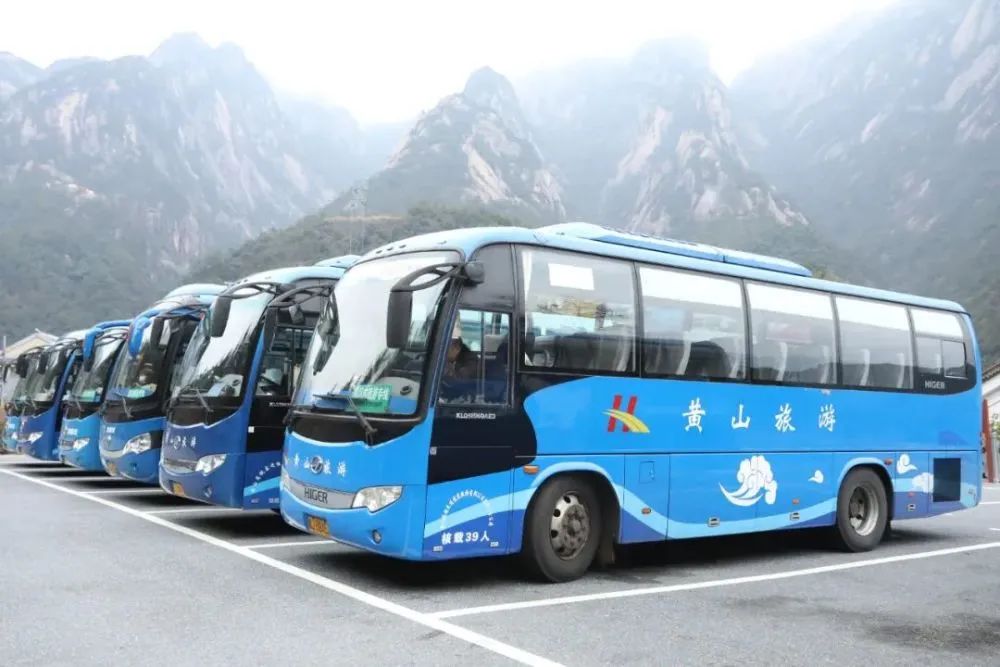
Preparation at the Foot of the Mountain
▪️ You can take the mountain shuttle bus from either Xin Guo Line or South Gate.
▪️ Hotels usually provide free shuttle services to and from Xin Guo Line.
▪️ There are self-service lockers at the entrance of Xin Guo Line, which cost 15 yuan per day.
▪️ Huangshan tickets are valid for three days and allow two entries.
▪️ When ascending the mountain, it’s advisable to bring more snacks and less water (drinking water is available on the mountain). Avoid bringing instant noodles as they are difficult to cook at high altitudes.
▪️ Before ascending, purchase hiking sticks, gloves, and raincoats. Wear sports shoes and bring a power bank and a windbreaker.
Ticket Reservation and Opening Hours
For convenience, it is recommended to purchase tickets online in advance.
💰 Official Price Reference
1) Scenic Area Ticket: 190 yuan/person
2) Scenic Area Bus: 19 yuan/trip
3) Yuping Cable Car: 90 yuan/trip
4) Yungu Cable Car: 80 yuan/trip
5) West Sea Mini Train: 100 yuan/trip
⚠️ Important Notes
① You need to queue on-site to purchase the downhill bus 🚌 tickets.
② Pay attention to the closing time of the downhill cable cars.
⏰ Opening Hours (Weekdays)
Cable Car Hours: 07:00-17:10
⚠️ On weekends and holidays, the opening hours are extended by 30 minutes before and after.
Surrounding Delicacies & Attractions
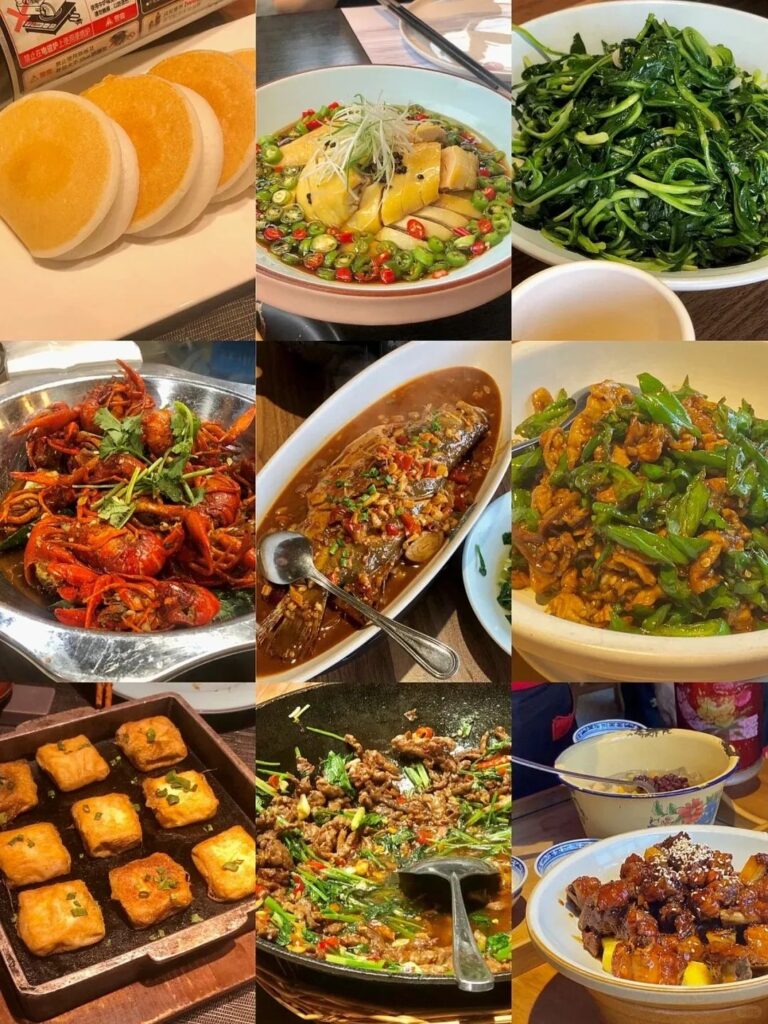
Huangshan is renowned for its stunning scenery, but its culinary delights are equally impressive! Don’t forget that this area was once part of Huizhou, where Hui cuisine originated. It would be a shame to visit Huangshan without indulging in a proper meal~
😋 Recommended Delicacies (For Reference Only)
Tangkou: Laojie Fang Hui Cuisine, Huangshan Hui Fu Cuisine
Tunxi Old Street: Huixiang Yuan Restaurant
Hongcun: Yunlong Restaurant
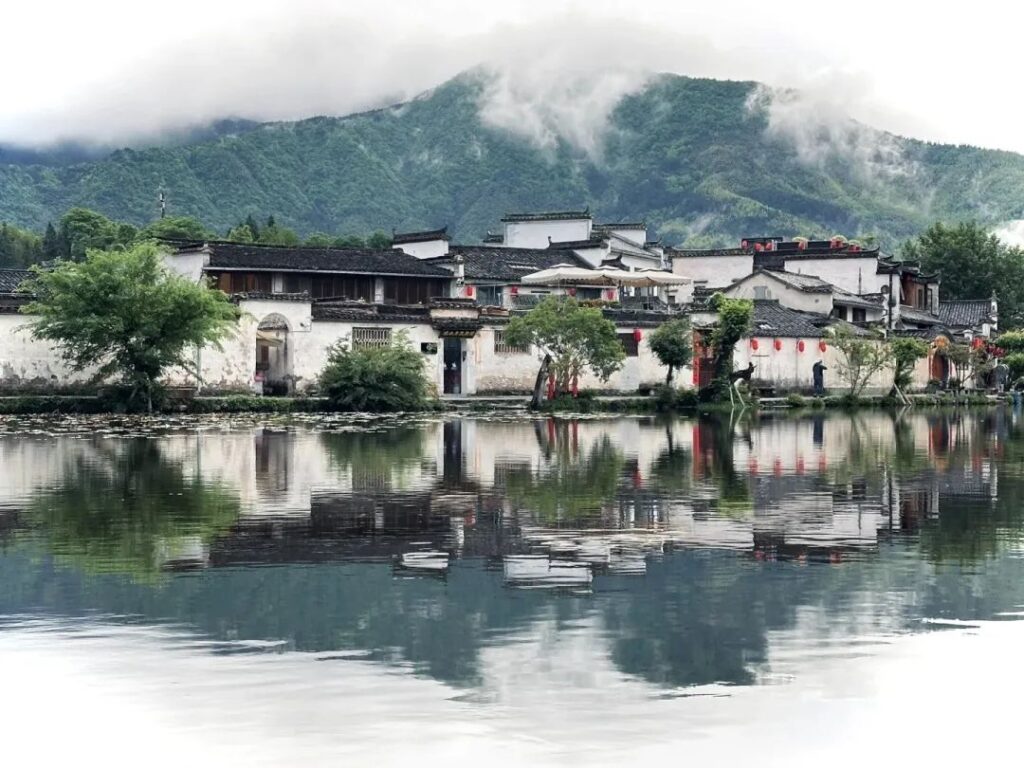
There are many other fascinating attractions around Huangshan. Hongcun and Xidi, both less crowded and incredibly beautiful, are well worth a visit.
They are typical representatives of Hui-style ancient architecture. Admire the white-walled and gray-tiled Hui-style buildings and experience the family traditions and life philosophies of the Huizhou people.
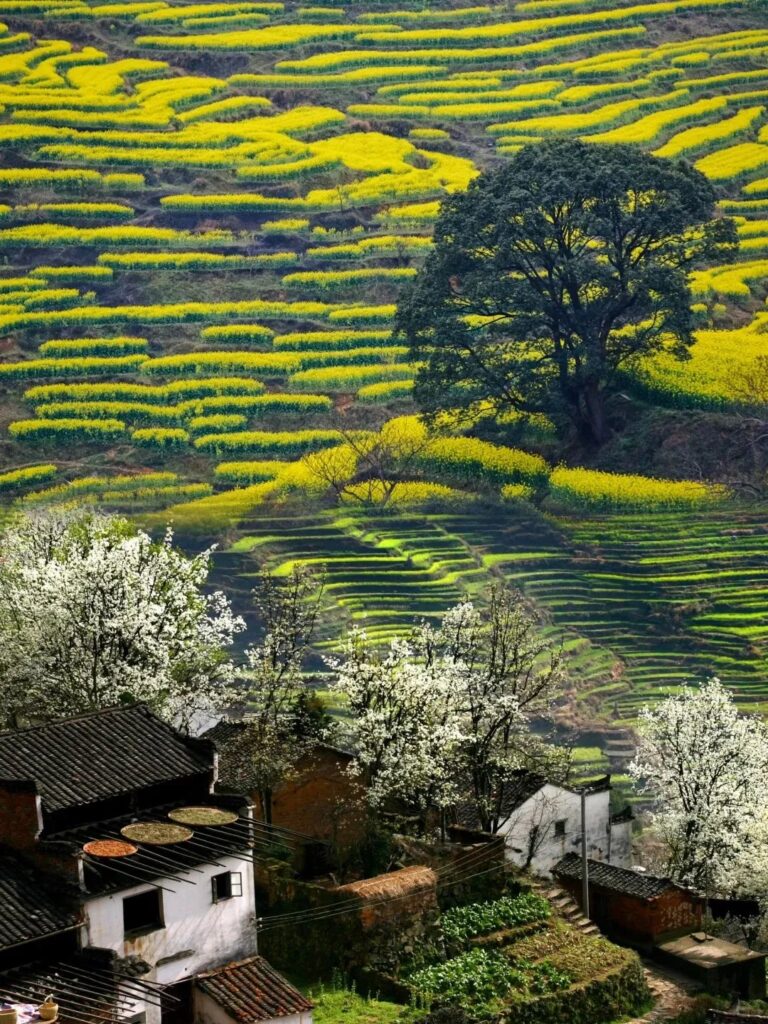

Wuyuan in Jiangxi Province and Qiandao Lake in Hangzhou are also nearby. For those with more time, these places can be included in your itinerary.
Transportation Information

✈️ By Air: You can arrive at Huangshan Tunxi International Airport and then take a bus or taxi to Huangshan Scenic Area.
🚄 By Train: Arrive at Huangshan Station or Huizhou Station, where buses or taxis are available to take you to Huangshan Scenic Area.
🚗 By Car: Set your navigation to “Huangshan Scenic Area.” There are clear signposts along the way.
🚌 By Bus: From Huangshan North Station (Huangshan Tourist Bus Center) to Huangshan Scenic Area (Xin Guo Line), buses run every half hour from 8:30 to 19:00. The fare is 30 yuan/person, and tickets can be purchased on-site or through Ctrip.
⚠️ Xin Guo Line is the bus station for Huangshan Scenic Area. Before 9 PM, there are shuttle buses available at the entrance to take you back to the high-speed rail station or Huangshan city center.
Accommodation Suggestions
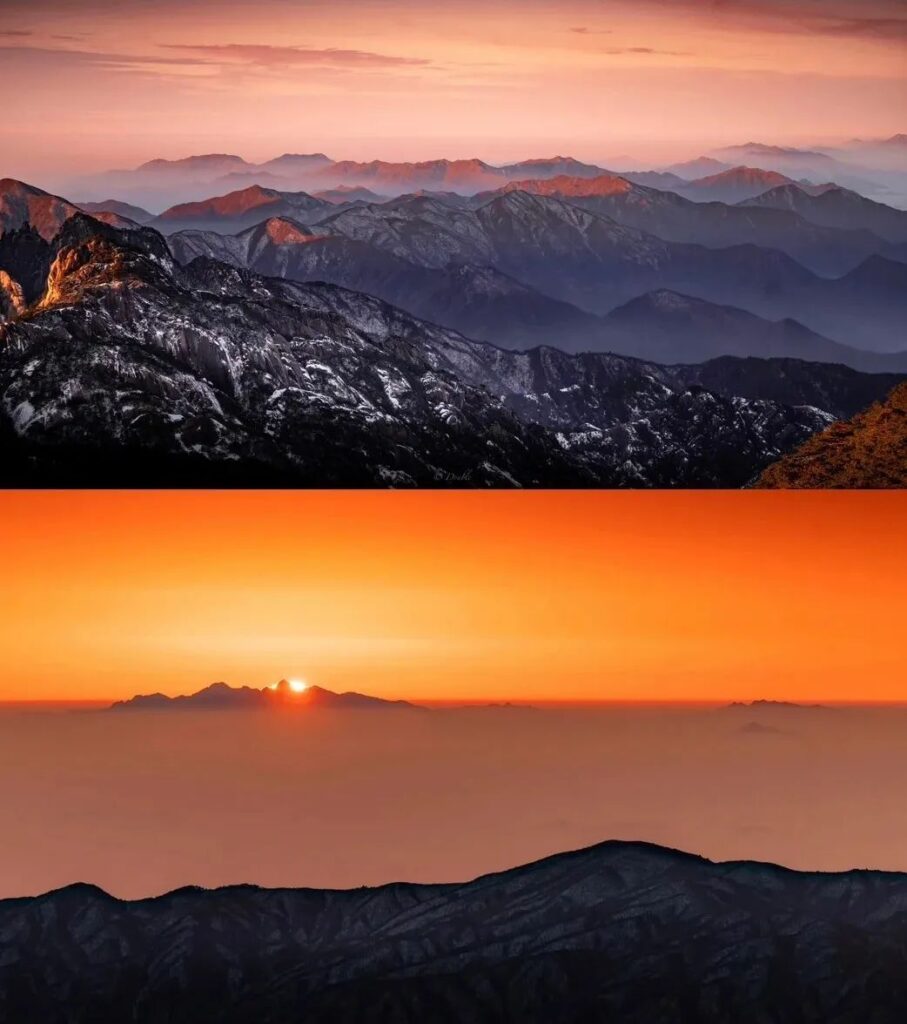
If you want to fully experience Huangshan, especially the stunning sunrises, sunsets, starry skies, and the Milky Way (truly beautiful), you must spend a night in Huangshan! There are two options: staying on the mountain or at the foot of the mountain. You can decide based on your preferences~
1) On the Mountain: Limited choices, higher prices, but you can watch the sunrise and sunset.
2) At the Foot of the Mountain: Tangkou Town offers more options, lower prices, and convenient dining and accommodation.
⚠️ You can also rent tents on the mountain by booking a day in advance through the official mini-program.
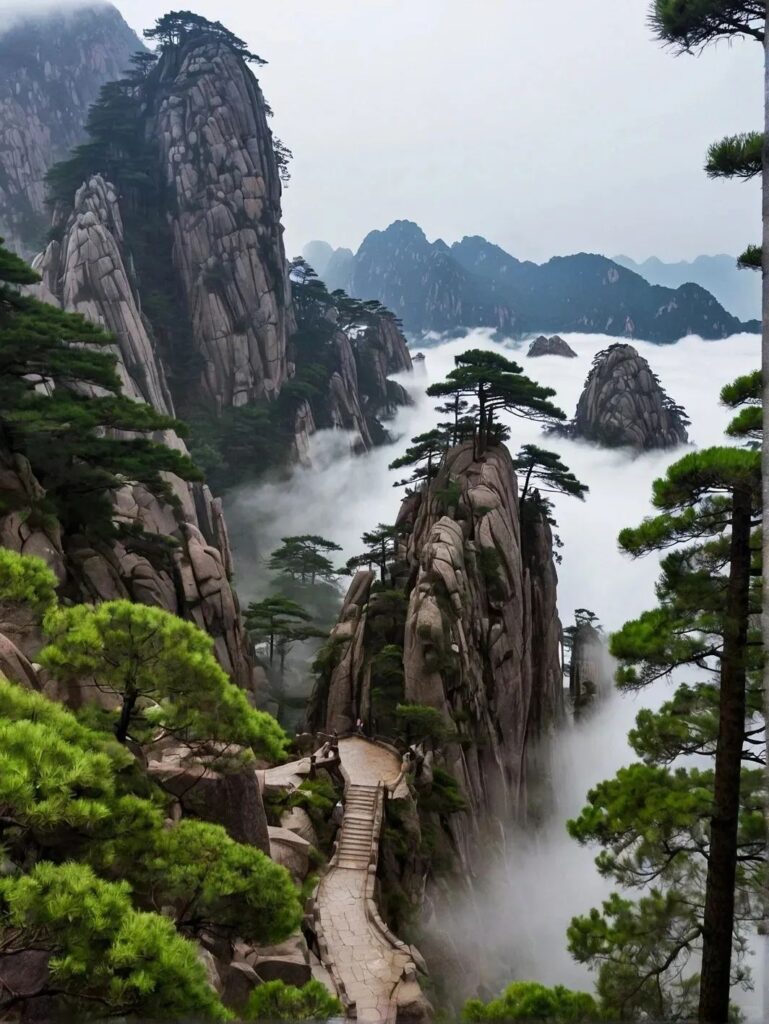
The above is the Huangshan travel guide compiled by the editor for everyone.
Quickly save it, avoid the crowds during long holidays, find a time, and set off to experience the magnificence of Huangshan!

